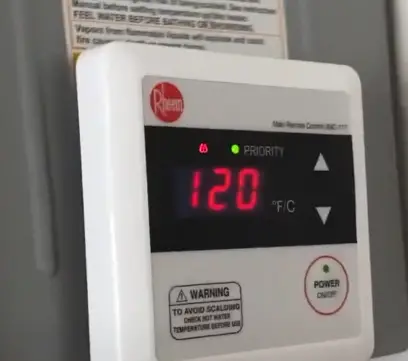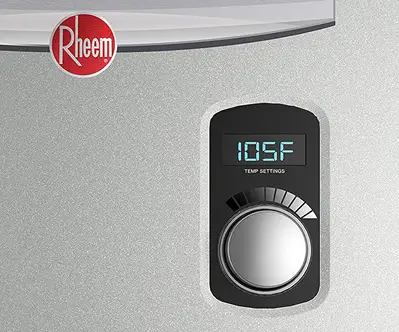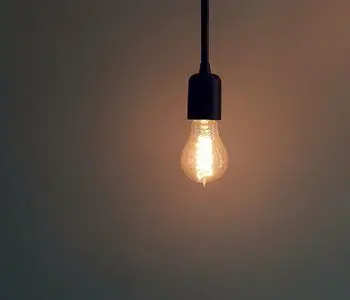Last Updated on: 11th December 2023, 07:31 pm
If you’re like me, you know there’s nothing more frustrating than hopping into a shower only to be greeted with a stream of cold water. That’s where tankless water heaters come in – they provide hot water on demand without needing a bulky tank.
Now, don’t get me wrong, these babies are a real game-changer when it comes to hot water, but like anything in life, they can have hiccups too.
That’s why I’m here to talk to you about Rheem tankless water heater troubleshooting. So, sit back, grab a cold one (or a hot one if you prefer), and let’s get to work!
Table of Contents
- Electric Tankless Water Heater Problems You May Encounter
- Will Not Power On
- No Hot Water, Not Heating With No Error Code
- Water Not Hot Enough
- Not Working After A Power Outage
- Control Panel Not Working
- Keeps Shutting Off
- Dripping Or Leaking Water From Bottom
- Makes Loud Noise
- Heater Neutralizer Clogged
- Making Lights Flicker In The House
- No Power To Remote Control
- No Water Flow Or Low Water Pressure
- Not Draining Condensation
- Conclusion
Electric Tankless Water Heater Problems You May Encounter
Will Not Power On

Your Rheem tankless water heater is not powering on, huh? Please don’t fret, my friend. We’ll get you up and running in no time. The first thing you should do is check the power source. Ensure the unit is wired correctly and the circuit breaker hasn’t tripped.
If everything looks good on the power front, it might be an issue with the unit itself. In that case, you should check the fuse or the control board. If you’re uncomfortable with these repairs, it’s best to call a professional plumber or electrician.
Trust me. You don’t want to mess around with electricity if you’re unsure what you’re doing. But with some troubleshooting and elbow grease, we’ll have that tankless water heater back up and running quickly!
No Hot Water, Not Heating With No Error Code
One common culprit for no hot water is a faulty coil. If the coil is not working correctly, it won’t heat the water, resulting in cold water from your taps. You can check the coil by using a multimeter to test for continuity. If the coil is bad, it will need to be replaced. Sometimes, there is no error code for this issue.
A faulty flow sensor is another common issue that can cause a lack of hot water. The flow sensor detects when water flows through the unit, which signals the heating element to start heating the water. If the flow sensor malfunctions, it won’t signal the heating element to turn on, resulting in no hot water. You can check the flow sensor by visually inspecting it for any damage or debris and testing it with a multimeter.
If you’re uncomfortable with these repairs, it’s best to call a professional plumber or technician to diagnose and fix the issue. But with some troubleshooting, we’ll have that hot water flowing again soon!
Water Not Hot Enough

The first thing you should check is the temperature setting on the unit. Make sure it’s set to the desired temperature, and adjust it if necessary.
If the temperature is suitable, you should check the water flow. If the water flow is too high, the unit may need more time to heat the water to the desired temperature. Try adjusting the flow rate to see if that makes a difference.
Another possible cause of water not being hot enough is a mineral buildup in the unit. Over time, mineral deposits can build up on the heating elements, reducing their efficiency and ability to heat the water. You can flush the unit with a descaling solution to remove mineral buildup.
If none of these solutions work, there may be a problem with the heating elements or some other unit component. In that case, it’s best to call a professional plumber or technician to diagnose and fix the issue.
Not Working After A Power Outage
First things first, check to see if any breakers have tripped. If you find tripped breakers, reset them and see if the unit starts working again.
If the breakers were fine, the power outage could have disrupted the gas or water flow to the unit. Check the water valves to make sure they’re open and flowing properly.
You may need to reset the unit if the water valves are good. Most Rheem tankless water heaters have a reset button or switch that you can use to reset the unit. Check the owner’s manual for your specific unit to locate the reset button or switch, and follow the instructions to reset the unit.
If none of these solutions work, the power outage could have damaged some unit components. In that case, it’s best to call a professional plumber or technician to diagnose and fix the issue.
Control Panel Not Working

The first thing you should check is the power source. Ensure the unit is plugged in and the circuit breaker hasn’t tripped. If everything looks good on the power front, it may be an issue with the control board.
If you’re comfortable with electrical work, check the control board for any loose or damaged wires and test the board with a multimeter. If you find any damaged components or loose wires, you can try repairing or replacing them.
If you’re uncomfortable with electrical work, it’s best to call a professional plumber or electrician to diagnose and fix the issue. They will have the tools and expertise to properly diagnose and repair the control panel.
Sometimes, the issue may be with the control panel, which must be replaced. Your plumber or technician can help you determine if this is the case and assist with ordering and installing a new control panel.
Keeps Shutting Off
One common cause of a tankless water heater shutting off is overheating. This can happen if the unit works too hard or the ventilation system is blocked or not functioning correctly. Ensure that the air intake and exhaust vents are clear of obstructions and that the ventilation system operates correctly. If the unit is still overheating, you may need to reduce the water flow rate or have a professional technician check the heat exchanger.
Another possible cause of the unit shutting off could be a problem with the flame sensor. The flame sensor is responsible for detecting the presence of a flame, and if it is malfunctioning, the unit may shut off as a safety precaution. You can check the flame sensor by visually inspecting it for any damage or debris and cleaning it with a soft cloth.
Dripping Or Leaking Water From Bottom
If you’re noticing water dripping or leaking from the bottom of your Rheem tankless water heater, there could be a few possible causes.
One common cause of water leaking from the bottom of the unit is a damaged drain valve. The drain valve is located at the bottom of the unit and drains the water out for maintenance or winterization purposes. Over time, the valve can become damaged or wear out, resulting in a leak. Try tightening the drain valve to see if that stops the leak. If tightening the valve doesn’t work, you may need to replace the valve.
A damaged heat exchanger is another possible cause of a leak from the bottom of the unit. The heat exchanger is responsible for heating the water; if it becomes damaged, it can leak water. If you suspect the heat exchanger is the problem, it’s best to call a professional plumber or technician to diagnose and fix it.
If the leak is due to a damaged drain valve, you can replace the valve yourself if you’re comfortable with plumbing repairs. If the issue is with the heat exchanger or if you’re uncomfortable with plumbing repairs, it’s best to call a professional plumber or technician to diagnose and fix it.
Makes Loud Noise

That can be a real nuisance, but don’t worry. We’ll get to the bottom of this quickly.
One common cause of a tankless water heater making loud noises is a buildup of mineral deposits on the heating elements. Over time, minerals in the water can accumulate on the heating elements, which can cause them to vibrate or make loud noises. You can flush the unit with a descaling solution to remove mineral buildup.
Another possible cause of loud noise is a loose or damaged part within the unit. Check the unit for loose or broken parts, and tighten or replace them as necessary. You can also check the fan and motor to ensure they function correctly and do not make unusual noises.
Heater Neutralizer Clogged
The neutralizer is a vital component that helps reduce the acidity of the exhaust gases from the unit. When the neutralizer becomes clogged, it can cause the unit to shut down or even produce carbon monoxide.
To clean the neutralizer, you’ll first need to shut off the water and gas supply to the unit. Once the unit is shut off, remove and clean the neutralizer with a descaling solution. Make sure to follow the manufacturer’s instructions when cleaning the neutralizer.
If the neutralizer is severely clogged or damaged, it may need to be replaced. In that case, it’s best to call a professional plumber or technician to diagnose and replace the neutralizer. They will have the tools and expertise to properly diagnose and repair the issue.
Remember, a clogged or damaged neutralizer is a serious issue that can pose a safety hazard. If you suspect your neutralizer is clogged, addressing the problem immediately is essential to prevent potential risks. So please don’t delay, my friend. Let’s get that neutralizer cleaned up and working correctly!
Making Lights Flicker In The House

If you’re experiencing lights flickering or other electrical issues when the unit is running, there could be a few possible causes.
One common cause of electrical issues is an overloaded circuit. Tankless water heaters require a lot of power to operate, and if the unit is connected to a circuit that is already overloaded, it can cause lights to flicker or even trip the circuit breaker. Connect the unit to a different circuit with less load, or have a professional electrician upgrade the circuit to handle the additional load.
Another possible cause of electrical issues is a problem with the unit’s electrical connections. Check the unit’s wiring for any loose or damaged connections, and tighten or replace them as necessary. You can also check the unit’s circuit board for any damaged components and replace them.
If the issue persists, there may be a problem with the unit’s grounding or your home’s electrical system. In that case, it’s best to call a professional electrician to diagnose and fix the issue.
No Power To Remote Control
Replace the batteries!
No Water Flow Or Low Water Pressure
The first thing you should check is the water supply to the unit. Make sure the water supply valve is open and flowing properly. If the valve is open, it could be an issue with the unit’s water filter. Check the filter for debris or buildup, and clean or replace it as necessary.
Not Draining Condensation
Condensation is a normal byproduct of tankless water heaters, but it must drain adequately to prevent damage to the unit and surrounding area.
The first thing you should do is check the condensate drain line for any blockages or obstructions. The drain line is typically located at the bottom of the unit and should be clear of any debris or buildup. Try cleaning the drain line with a wire or a small brush to remove obstructions.
If the drain line is clear, it could be an issue with the condensate trap. The condensate trap collects condensation and prevents it from entering the drainage system. Check the trap for any blockages or debris, and clean or replace it as necessary.
If the drain line and trap are both clear, then it could be an issue with the unit’s condensate pump. The pump is responsible for pumping the condensation to a drainage point. Check the pump for any blockages or damage, and replace or repair it as necessary.
If none of these solutions work, there may be a problem with the unit’s control board or some other unit component. In that case, it’s best to call a professional plumber or technician to diagnose and fix the issue.
Download The User And Troubleshooting Manual
Find a link to download the Rheem tankless water heater user manual here.
Conclusion
We’ve covered a lot of ground when troubleshooting Rheem tankless water heaters. From issues with power and control panels to leaks and loud noises, several potential problems can arise with these units.
With a little bit of troubleshooting and some expert help, most issues can be resolved quickly and easily. Some solutions can get your tankless water heater back up and running quickly, whether dealing with a clogged neutralizer, a malfunctioning flow sensor, or an overloaded circuit.
So don’t let these issues get you down, my friend. With some troubleshooting and expert help, your Rheem tankless water heater will be running smoothly and reliably for years to come!
